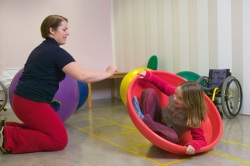Rehabilitation for Children with Brain Tumors
Bringing home your child after treatment for a brain tumor is a milestone event. But it's not the end of the treatment journey. After brain tumor treatment, it's normal for a child to have after-effects. For instance, your child may have trouble talking, walking normally, or swallowing. Rehab therapy can lessen these problems. Therapy can also help your child turn to normal activities, such as attending school. Children's brains are able to form new connections. As a result, children can often recover neurological functions that were affected by a brain tumor.

It's important to know what lies ahead for your child and the rest of your family. Understanding the rehabilitation (rehab) process may ease some worries for the next step in the recovery process.
Types of rehab help
Types of therapy your child may need include:
Physical therapy
Occupational therapy
Retraining of thinking skills
Speech-language pathology services
You can learn more about these below.
Physical therapy
If your child is having trouble moving and walking as a result of a tumor or treatment, a physical therapy (PT) can help. A PT helps improve both strength and movement through special exercises. They can help your child learn different ways to move. The PT can also show your child how to use special equipment, such as a leg brace to help them walk. PT can be done on an outpatient basis. This means your child goes home each day. In some cases, PT is done in an inpatient program. For this, your child would stay in a facility for days or weeks.
Occupational therapy
After treatment for a brain tumor, your child may have trouble doing daily tasks. These can include showering and eating. An occupational therapist (OT) will show your child how to regain these skills and be as independent as possible. An OT may use specific exercises, offer special devices, or teach your child a new way to do a task. In some cases, the OT may advise putting special equipment in your home to help with safety and mobility. These devices might include rails or grab bars in the bathroom. Health insurance may cover the cost of these things. But check your policy and talk with the OT before buying anything.
Psychology
It's normal for a child to be scared or sad during and after treatment for the brain tumor. Make it clear that the illness is no one's fault. During this time, your child may be helped by a pediatric psychologist or neuropsychologist. Brain tumors and their treatment can cause short- or long-term problems with behavior and learning. These experts will do an evaluation. They will come up with a program to help your child move forward. They also help children deal with the emotional stress of an illness. They also can serve as an advocate for your child at school so that he or she get the attention needed.
Retraining of thinking skills
Attention and memory can be affected by a brain tumor. Children can start to regain these thinking skills by doing simple exercises in workbooks, puzzles, and games. They can improve their ability to solve problems and reason. Be sure to choose workbooks that are meant for your child's age. Make sure the exercises aren't too hard or too easy. These workbooks can be found at most retail stores and at teacher-supply outlets. Be sure to discuss the exercises with your child's healthcare provider before starting them.
Speech-language pathology services
Communicating may be hard for a child recovering from a brain tumor. This is more true if the tumor was in a part of the brain that controls speech and language. A speech-language pathologist (SLP) can assess your child. The SLP can help treat any communication problems with speaking exercises, listening activities, or other methods. An SLP can also help with swallowing problems.
Talk with your child's healthcare provider if you think your child could be helped by working with an SLP or any other specialist. You and your child may also benefit from joining a support group for families of brain tumor patients.
Including other family members in rehab
This kind of experience affects an entire family. Try to make special time for siblings. Include them as much as possible in the rehab process. It may also help to consider family counseling, or support groups that include siblings. The rehab process focuses on the child recovering from the brain tumor. But it also needs to help the entire family recover from the event.
Connect with us:
Download our App: